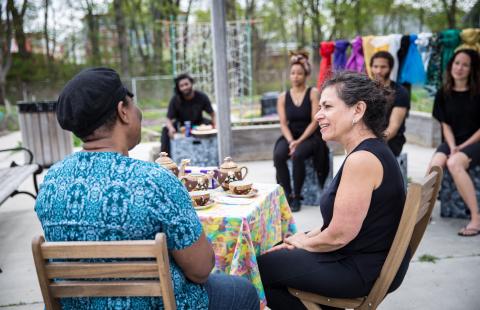What were the specific goals of this creative economy project? Describe the community development challenge or opportunity that your project was designed to address:
Specific goals were: form a community based ensemble; create successful interventions at The Table; devise and perform a play that addressed the issue of inclusion at a time where xenophobia and racism was at the forefront of the national dialogue. Additionally, an important goal was to provide community residents access to a theatrical experience that reflected the personal and social issues of their stories in the three main languages (English, Spanish, and Cape Verdean Creole) spoken in this community. Public, interactive, free, and multi-lingual theatre in Dorchester/Roxbury by members of the community was an opportunity to offer back to the community the heart of their own stories, increase understanding of the "other", and entertain. A warm and welcoming environment in the dead of winter was a part of the project design.
If the goals change over time, please describe how:
Once the goal of forming a community based ensemble was achieved, Red Sage Stories began responding to other community initiatives and our goal to perform expanded.
Who was involved in this project and what did they do? (be sure to include the partners from outside of the creative sector and how local voices were included):
DSNI was the partner institution. DSNI's Arts Manager, Ramona Lisa Alexander, provided guidance in creating a project timeline and in procuring rehearsal space at DSNI. Actors from the larger Playback Theatre community performed in the first performance offered at DSNI. Eight people who had some connection to the Dorchester/Roxbury community (residency, work, school, family, church or other community) trained and became the members of Red Sage Stories/Playback Theatre & Art for Social Change. Community organizers at DSNI shared their stories and watched actors create theatre on the spot. The Dudley Cafe owner, Biplaw Rai, donated space, tea and deserts during performances. Customers sat at the "welcome table", told their story and then witnessed the immediate and improvised dramatization. Leaders of the Nightingale Community Gardens were engaged in promoting the event; gardeners told their stories and saw them brought to life. In the lobby of the iconic Strand Theatre, local residents stopped by to tell their story and stayed to watch and comment on the experience. The final play, "The Bus", devised from these stories, was performed at the Dudley Cafe and the Strand Theatre Lobby but the day programmed to perform "The Bus" rain prohibited an outdoor performance so an alternate location was found indoors at a local shopping mall. The culminating
performance was for the 600 attendees at DSNI's Annual Meeting.
How does this project relate to a larger community development strategy?
Fundamental to the community development strategy of DSNI are inclusive, diverse, and innovative activities. By lifting up the voices of all the groups of the community, Red Sage Stories honors the unique voice of each teller while providing accompanying audience observers with the opportunity to discover the shared and common experience. This theatrical experience results in community building and enhanced understanding.
What projects or places, if any, inspired your approach to this creative economy project?
The Table/La Mesa: the Welcome Project was the subsequent iteration of "The Door" - a project commissioned through ExpressingBoston, led by the Design Studio for Social Intervention and funded by the Barr Foundation and the Boston Foundation. The Door was an installation/performance piece that welcomed anyone who knocked on the door to anytime or place where they had not been welcomed. I was also inspired by being a "radical welcomer" and group facilitator at Anna Deavere Smith's play "Notes From the Field: Doing Time in Education".
